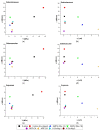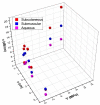Noninvasive Detection, Tracking, and Characterization of Aerogel Implants Using Diagnostic Ultrasound
- PMID: 35215635
- PMCID: PMC8875680
- DOI: 10.3390/polym14040722
Noninvasive Detection, Tracking, and Characterization of Aerogel Implants Using Diagnostic Ultrasound
Abstract
Medical implants are routinely tracked and monitored using different techniques, such as MRI, X-ray, and ultrasound. Due to the need for ionizing radiation, the two former methods pose a significant risk to tissue. Ultrasound imaging, however, is non-invasive and presents no known risk to human tissue. Aerogels are an emerging material with great potential in biomedical implants. While qualitative observation of ultrasound images by experts can already provide a lot of information about the implants and the surrounding structures, this paper describes the development and study of two simple B-Mode image analysis techniques based on attenuation measurements and echogenicity comparisons, which can further enhance the study of the biological tissues and implants, especially of different types of biocompatible aerogels.
Keywords: B-mode; acoustic attenuation; aerogel; ultrasound.
Conflict of interest statement
The authors declare no conflict of interest.
Figures











Similar articles
-
In vivo ultrasonic detection of polyurea crosslinked silica aerogel implants.PLoS One. 2013 Jun 14;8(6):e66348. doi: 10.1371/journal.pone.0066348. Print 2013. PLoS One. 2013. PMID: 23799093 Free PMC article.
-
Histological evaluation of the biocompatibility of polyurea crosslinked silica aerogel implants in a rat model: a pilot study.PLoS One. 2012;7(12):e50686. doi: 10.1371/journal.pone.0050686. Epub 2012 Dec 12. PLoS One. 2012. PMID: 23251378 Free PMC article.
-
Harmonic tracking of acoustic radiation force-induced displacements.IEEE Trans Ultrason Ferroelectr Freq Control. 2013 Nov;60(11):2347-58. doi: 10.1109/TUFFC.2013.6644738. IEEE Trans Ultrason Ferroelectr Freq Control. 2013. PMID: 24158290 Free PMC article.
-
An emerging platform for drug delivery: aerogel based systems.J Control Release. 2014 Mar 10;177:51-63. doi: 10.1016/j.jconrel.2013.12.033. Epub 2014 Jan 4. J Control Release. 2014. PMID: 24394377 Review.
-
Advances in 4D medical imaging and 4D radiation therapy.Technol Cancer Res Treat. 2008 Feb;7(1):67-81. doi: 10.1177/153303460800700109. Technol Cancer Res Treat. 2008. PMID: 18198927 Review.
Cited by
-
3D-printed aerogels as theranostic implants monitored by fluorescence bioimaging.Bioact Mater. 2024 Aug 8;41:471-484. doi: 10.1016/j.bioactmat.2024.07.033. eCollection 2024 Nov. Bioact Mater. 2024. PMID: 39220405 Free PMC article.
-
Radioactivity/Radionuclide (U-232 and Am-241) Removal from Waters by Polyurea-Crosslinked Alginate Aerogels in the Sub-Picomolar Concentration Range.Gels. 2023 Mar 10;9(3):211. doi: 10.3390/gels9030211. Gels. 2023. PMID: 36975660 Free PMC article.
-
3D-Printed Cellulose Aerogels Minimally Cross-Linked with Polyurea: A Robust Strategy for Tissue Engineering.ACS Appl Mater Interfaces. 2025 Jun 11;17(23):34444-34457. doi: 10.1021/acsami.5c08389. Epub 2025 May 28. ACS Appl Mater Interfaces. 2025. PMID: 40433903 Free PMC article.
-
Polylactide-Grafted Metal-Alginate Aerogels.Polymers (Basel). 2022 Mar 21;14(6):1254. doi: 10.3390/polym14061254. Polymers (Basel). 2022. PMID: 35335584 Free PMC article.
-
Evaluation and analysis of surgical treatment for single-level or multi-level lumbar degenerative disease based on radiography.Quant Imaging Med Surg. 2024 Feb 1;14(2):1441-1450. doi: 10.21037/qims-23-1108. Epub 2024 Jan 23. Quant Imaging Med Surg. 2024. PMID: 38415163 Free PMC article.
References
-
- Maulik D. Doppler Ultrasound in Obstetrics and Gynecology. Springer; Berlin, Germany: 2005. Biological safety of diagnostic sonography; pp. 9–111. - DOI
LinkOut - more resources
Full Text Sources

